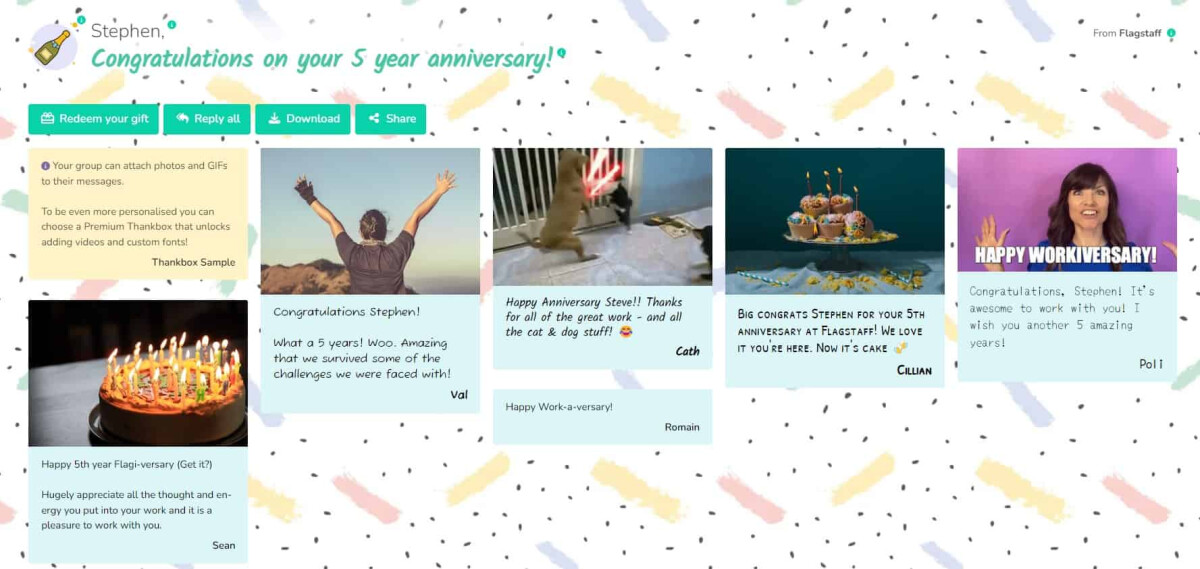We Explore the Future of the Workplace: Hybrid Working & How You Can Make it Work


It’s no secret that the structure and nature of the workplace have shifted.
After having to test new work arrangements when the world went into lockdown, employees are favouring hybrid work to provide them with greater flexibility in life. Now, it seems like the hybrid working model might just take over the full-time office working model.
But what does “hybrid work” really mean? And what does it take to make it work?
Join us at Thankbox as we dive into the intriguing world of hybrid work. We’ll look at its benefits, drawbacks, and how you can seamlessly incorporate this promising, alternative model into your workplace.
Let’s dive in!
What is hybrid work?
Essentially, hybrid working encompasses both in-office and remote work. It’s a flexible working schedule that allows your employees to split their time between working in the physical office and working from home.
You’ll find that hybrid jobs don’t take a one-size-fits-all approach, and there are three major hybrid work models:
Fixed model: Here, there are scheduled days for remote or in-office work (e.g. certain teams in the office on specific days / three mandatory days in the office per week).
Office-first model: Employees will be expected to work in-office, but have the option to individually choose when they prefer to work remotely once or twice a week.
Remote-first model: Primarily remote work with occasional office visits for meetings, collaboration, or training.
For many employees, the ideal hybrid work situation integrates all the pleasant parts of work (like socialisation, collaboration, and consistency) without the unpleasant parts (like fixed hours and a full week sitting at a desk like a robot.
Why are hybrid jobs gaining popularity?
It should come as no surprise that hybrid jobs are gaining more popularity, especially after the COVID-19 pandemic. Companies were forced to adopt remote working, and as it turns out, many people realised that being in the office consistently wasn’t all that necessary.

Employees are finding that they can be more productive at home, especially with the time it takes to get ready for work and commute. Even more, with more discoveries on how burnout greatly affects office employees, there is a greater focus on well-being and a healthy work-life balance.
Facilitate recognition and deep connections in your hybrid workplace with Thankbox. You’ll be able to encourage collaboration and strengthen your company culture in seconds!
Hybrid work: The good and the bad
Although hybrid work doesn’t have a one-size-fits-all approach, no matter how it's implemented, you can experience similar advantages and challenges.
The good
Increased flexibility and productivity: The balance between home and office work promotes a better work-life balance, which has a positive impact on productivity.
Employee autonomy: Employees will have the opportunity to discover their own unique working styles. This sense of autonomy is great for employee empowerment.
Cost reduction: Hybrid work allows you to reduce commuting costs and provides the opportunity to scale down your office space.
Sustainability: By reducing commuting and office usage, you can contribute to lower CO2 emissions.
Expansion of talent pool: Companies can attract a more diverse range of talent.
The bad
Potential for inequality: Issues with fair recognition based on visibility can arise, favouring in-office employees.
Difficult to maintain company culture: Remote workers might feel isolated or less integrated. Also, with multiple teams working in-office at different times, company culture can feel disjointed.
Reduced socialisation and networking: The synergy of employees can suffer during a remote switch because you can’t just drop by someone’s cubicle to ask a question or have a casual chat. This tends to be what employees miss about working in-office.
How to overcome the challenges of hybrid working
Now that we understand what hybrid work is, as well as its benefits and challenges, let’s dive into how you can make this popular working model successful.
Develop a culture of consistent recognition
To make it work, hybrid work needs community. And what better way to encourage community than prioritising employee recognition and celebrating milestones? Now, you may be wondering how you can achieve this when all your employees may not be in-office at once.
Fortunately, Thankbox has you covered!

Our online group greeting card allows you to involve your entire team in expressing their appreciation in a personalised way. You’ll be able to send sentimental messages brimming with GIFs, photos, and videos. Or, go a step further by including a group gift card (redeemable at 700+ retailers) and a lovely bouquet of flowers with your e-card.
It’s the perfect way to celebrate milestones and achievements, boost staff morale, and keep everyone connected without being in the office.
Broaden your communication channels
A common worry for organisations is that hybrid work can put a dent in company culture. One of the best ways to do this, besides consistent employee recognition, is to implement multiple communication channels that include employees working remotely in discussions and decisions.
So, even though you may have a main office, you should consider using platforms like Slack to keep everyone in the loop of what’s going on.

Accommodate virtual teams as best as you can by encouraging digital-first people processes that Make sure your employees feel included even when they’re working from home. This means that when you’re preparing for meetings, the option to join in via Zoom call should always be available.
Provide all-inclusive collaborative spaces
It’s important to consider that one of the major reasons employees may opt for hybrid working instead of completely remote is that they still desire the opportunity to connect with their colleagues in-person.
Also, you may have employees with unique tasks that require them to stay in the office. The best way to remedy this is to provide a meeting and collaboration space that’s video-enabled, so nobody is left out. It’s a great chance for your different departments to meet when they need to.

Encourage employee feedback (and respond to it!)
The only way you’ll know if the hybrid work model you’ve implemented is beneficial for your employees is if you ask them for feedback. Find out if their well-being is improving and if the new schedule helps them complete their tasks more efficiently.
Continuously learn from your mistakes
There’s no harm in trying and failing. After all, a plus side to the hybrid work model is that you can customise it to your company’s requirements.
If a specific approach isn’t working for the greater good of the team, you can strategize and test out different schedules until you find your sweet spot.
Facilitate recognition and deep connections in your hybrid workplace with Thankbox. You’ll be able to encourage collaboration and strengthen your company culture in seconds!
Wrapping up
We can’t escape it, the future of the workplace is hybrid. But no worries, with our suggestions, we’re sure you’ll be able to embrace it and make it work for your organisation.
Similar to how hybrid work blends remote and in-office work, Thankbox blends digital and traditional card-giving experiences. Our unique platform offers an innovative and sustainable way to keep your team together, no matter where they work.
Create a Thankbox today and let your team know just how much each of them is valued!
Images: Cover | Man using a laptop | Team in a virtual meeting | Group of people discussing projects in a shared space





